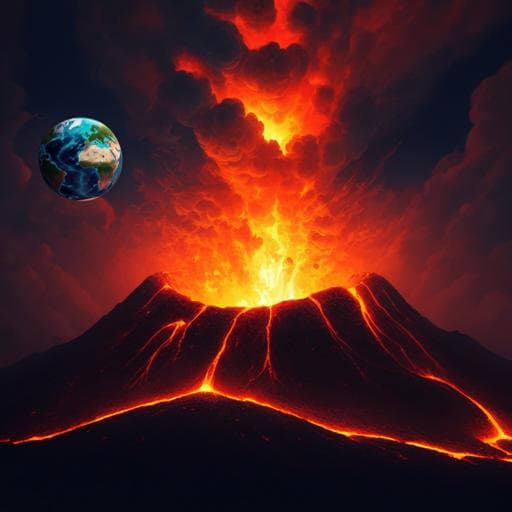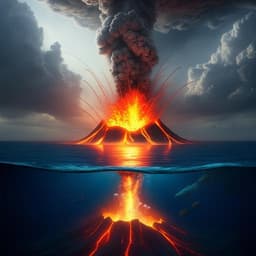
Earth Sciences
Atmosphere-solid earth coupling signals generated by the 15 January 2022 Hunga-Tonga eruption
J. Diaz
Discover the groundbreaking research by Jordi Diaz on the January 15th 2022 Hunga-Tonga volcanic eruption, one of the most powerful explosions in recent decades. This study explores the eruption's dynamics and its unprecedented atmospheric wave propagation, making waves around the globe!
~3 min • Beginner • English
Introduction
Hunga-Tonga, a submarine volcano in the South Pacific, exhibited powerful activity culminating on 15 January 2022 in one of the most energetic volcanic explosions in recent decades, with an estimated energy release of 4–18 megatons of TNT. The eruption lofted material to 50–55 km altitude, generated a plume roughly 600 km in diameter, widespread ionospheric disturbances, hundreds of thousands of lightning strikes, a Pacific-wide tsunami, and a loud atmospheric acoustic blast heard thousands of kilometers away. A prominent global atmospheric pressure disturbance was interpreted as a Lamb wave, a non-dispersive atmospheric mode propagating near 0.310 km/s that efficiently transfers energy over great distances.
The study aims to use global broadband seismic data to: (i) refine the temporal evolution of the eruption; (ii) characterize seismic recordings of the atmospheric wave as it circled the Earth multiple times; and (iii) document and interpret long-duration, very low frequency seismic signals following the eruption as excitation of Earth’s normal modes. These observations are significant because they document exceptionally long-lived atmosphere–solid Earth coupling and rare normal-mode excitation by a volcanic source, with only a few precedents historically.
Literature Review
Previous works documented the eruption’s atmospheric and remote-sensing signatures, including satellite-derived plume heights and dynamics and ionospheric disturbances. Lamb waves from large atmospheric explosions are known to propagate globally near acoustic speed. Prior seismoacoustic studies have shown that barometric pressure changes and atmospheric waves can be imprinted on broadband seismic records via Newtonian attraction effects. Reports of normal-mode excitation by volcanic eruptions are rare, with notable examples following the 1982 El Chichón and 1991 Mount Pinatubo eruptions, where bichromatic excitation near a few millihertz was observed. Theoretical frameworks (e.g., PREM eigenfrequencies, atmospheric–solid Earth coupling and normal-mode summation) provide tools to interpret such low-frequency signals and predict enhanced coupling where atmospheric modes carry more energy. Recent infrasound and satellite studies specific to Hunga-Tonga constrained eruption onset, sub-events, and the emergence of the Lamb wave, providing context for the seismic analyses presented here.
Methodology
- Data sources: Selected broadband seismic stations from global networks (Global Seismograph Network IU and II, Geoscope G, GEOFON GE) and regional networks in SW Europe (FR, ES, CA). Used LHZ channels at 1 sample/s.
- Time frame and catalogs: Compared with USGS and ISC catalogs and prior satellite/infrasound timing to place seismic arrivals in temporal context.
- Processing: Removed instrument response (ObsPy). Computed spectra and spectrograms (SAC and ObsPy) using standard parameterizations. Particle motion analyses for phase characterization. Traces were often band-pass filtered to isolate signals: 0.01–0.04 Hz for very-long-period (VLP) eruption signals; 0.5–5 mHz for atmospheric Lamb waves; 2.5–6.5 mHz for post-eruption low-frequency signals.
- Analysis steps: (1) Identified early low-frequency onsets at nearest stations (distances ~750–2485 km), examined spectrograms and particle motions to classify Rayleigh-wave-like VLP arrivals. (2) Characterized complex main-event waveform, searched for repeating sub-pulses using waveform similarity across closely spaced stations and lag times (~184–228 s). (3) Detected additional explosions via coherent low-frequency arrivals around 05:30 and ~08:25 UTC and tracked move-out and amplitude decay with distance, estimating detectability up to ~17,700 km and inferring magnitude thresholds by comparison with ISC-reported global detections. (4) Tracked atmospheric wave passages globally by aligning low-frequency (mHz) transients with expected Lamb-wave travel times along short and long great-circle paths; identified successive circumambulations over multiple days. (5) Mapped long-duration near-monochromatic signals (2.5–6.5 mHz) across the network, built stacked amplitude spectra over 24 hours for 95 stations, and compared peaks with PREM eigenfrequencies to infer normal-mode excitation.
Key Findings
- Eruption timing and structure:
- Seismic data reveal an initial low-frequency onset around 04:02 UTC at the nearest station (FUTU), predating cataloged origin times and consistent with satellite and infrasound constraints for eruption start (~04:00–04:02 UTC).
- The main explosive event near 04:15 UTC exhibited two VLP energy packets separated by ~200 s; sub-pulse similarity indicates episodic, repeating source behavior over minutes.
- Two additional large explosions were identified: ~05:30 UTC (cataloged M4.7; linked to a lower-altitude umbrella cloud) and ~08:25–08:31 UTC (globally observed in seismic data but not cataloged, with detectable signals to ~17,700 km suggesting magnitude >4.6–4.8 despite very low-frequency content).
- Atmospheric waves:
- A strong Lamb wave propagated globally at ~310 m/s; first arrivals at far-field stations occurred ~16 hours after origin, with two initial arrivals along short and long great-circle paths separated by ~4 hours.
- A second, dispersive atmospheric wave overlapped the first passage at some stations, with frequencies near ~1 mHz arriving minutes after the Lamb wave and up to ~40 mHz arriving ~45 minutes later, consistent with gravity/pressure waves.
- Multiple circumambulations were recorded seismically: clear second and third passages were observed, and stations away from source and antipode recorded up to five Lamb-wave passages over ~3.5 days (~36 h per circumnavigation), evidencing exceptional energy.
- Low-frequency near-monochromatic signals and normal modes:
- Long-duration (10–12 h) signals between 2.5–6.5 mHz appeared globally after the eruption; prominent energy centered near ~3.7 mHz with additional groups near ~4.5, ~5.3, and ~6.0 mHz.
- Stacked spectra from 95 stations show peaks aligned with PREM eigenfrequencies, indicating excitation of Earth’s normal modes (Earth’s Hum) by the atmospheric source, with enhanced amplitudes where atmospheric modes carry more energy.
- Amplitudes tend to increase near antipodal regions; a secondary amplitude increase around 09:00–10:00 UTC corresponds to surface waves from the ~08:30 explosion, suggesting reinforcement of mode excitation.
- Spatial/temporal extent:
- VLP and atmospheric signals were detected across epicentral distances up to ~17,700 km; Lamb-wave passages persisted for at least 3.5 days and traveled >100,000 km in total path length.
Discussion
The results address the study’s three aims. First, seismic evidence refines the eruption chronology: activity began around 04:02 UTC, the main explosion near 04:15 UTC had repeating VLP sub-pulses, and two subsequent large explosions occurred at ~05:30 and ~08:25–08:31 UTC. The repeatability and similarity of VLP waveforms across sub-pulses and later events indicate an episodic, stable source process over minutes to hours, plausibly associated with magma/gas dynamics.
Second, the atmospheric Lamb wave produced a strong and unusually persistent seismic signature, recorded globally for multiple Earth-circling passages. The detection of both short- and long-path first arrivals and the observation of an overlapping dispersive wave (likely gravity/pressure waves) highlight complex atmospheric wavefields generated by the eruption. Lack of dispersion in later passages suggests that the durable seismic signatures primarily reflect pure Lamb-wave energy after initial cycles, possibly due to attenuation of higher-frequency atmospheric components.
Third, the emergence of long-duration, near-monochromatic seismic energy between 2–6 mHz, with spectral peaks matching PREM normal-mode frequencies and enhanced amplitudes near expected coupling regions, supports excitation of Earth’s normal modes by atmospheric forcing from the eruption. The temporal reinforcement concurrent with surface waves from the late (~08:30 UTC) explosion further supports sustained or renewed excitation. These findings demonstrate exceptional atmosphere–solid Earth coupling over multi-day timescales and expand the limited set of documented volcanic excitations of Earth’s normal modes.
Conclusion
Global broadband seismic analyses reveal that the Hunga-Tonga eruption began minutes earlier than seismic catalogs indicate, comprised a main VLP-rich explosion followed by at least two further large explosions (~05:30 and ~08:25 UTC), and produced a powerful atmospheric Lamb wave recorded seismically for 3.5 days as it circled the Earth multiple times. Many stations also recorded a concurrent dispersive atmospheric wave during the first passage. Additionally, long-duration low-frequency (2–6 mHz) signals consistent with excitation of Earth’s normal modes were observed worldwide, with dominant energy near 3.7 mHz and additional peaks around 4.5, 5.3, and 6.0 mHz that align with PREM eigenfrequencies. These observations document unprecedented longevity of atmosphere–ground coupling from a volcanic source and add a rare case of eruption-driven normal-mode excitation.
Future work should include detailed forward modeling of atmospheric–solid Earth coupling to reproduce observed spectra and spatial patterns; investigation of the source mechanisms behind the repeating VLP pulses; and quantitative characterization of the dispersive atmospheric waves to determine their nature (e.g., gravity-wave components) and attenuation over successive global passages.
Limitations
- The ~08:25–08:31 UTC explosion is not listed in standard seismic catalogs, likely due to very low-frequency content; its magnitude estimate (>4.6–4.8) is indirect, inferred from detectability at great distances and comparison with catalog statistics.
- Not all stations showed clear atmospheric wave or low-frequency signals, reflecting variable site conditions, sensor orientations, and noise levels.
- Identification and interpretation of the dispersive atmospheric wave rely on spectro-temporal patterns; definitive classification (e.g., gravity vs pressure wave) requires further atmospheric modeling.
- The proposed episodic VLP source mechanism is qualitative; no detailed source inversion was performed to resolve geometry or dynamics.
- Normal-mode attribution is based on spectral alignment with PREM eigenfrequencies and global consistency; comprehensive coupled atmosphere–Earth normal-mode modeling was not executed in this study.
Related Publications
Explore these studies to deepen your understanding of the subject.







